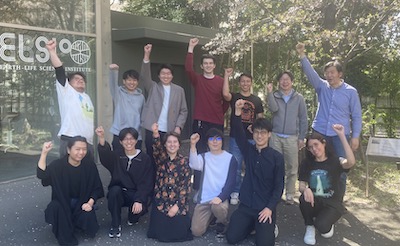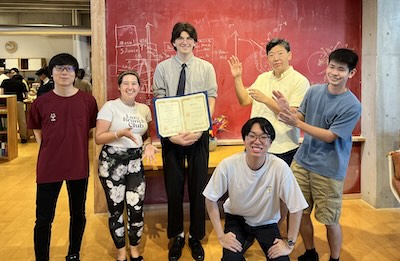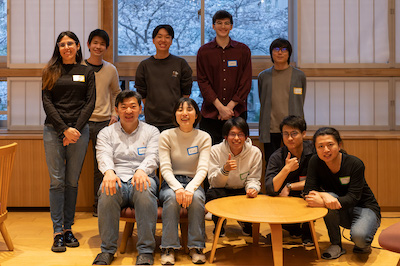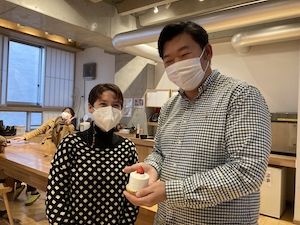| 2025/04/09 |
We took a group photo of Genda-lab (+ Kodama-lab).
. 
|
| 2025/04/01 |
New fiscal year just started. Member list was updated.
|
| 2024/12/17 |
Professor Genda's co-authored paper has been published in Nature Geoscience. This paper showed that the age of Saturn's rings is older than the previously estimated 100 to 400 million years and could be consistent with the age of the Solar System (4.5 billion years).
Hyodo, R., Genda, H., and Madeira, G. (2024) Pollution resistance of Saturn's ring particles during micrometeoroid impact. Nature Geoscience. / Nature Geoscience HP
|
| 2024/09/20 |
The ELSI course student from the Genda Lab has completed his master's degree. Congratulations, Jared!
. 
|
| 2024/04/15 |
New fiscal year just started. Member list was updated.
|
| 2024/04/04 |
We took a group photo of Genda-lab. Sorry, Courteney. You were in U.S.
. 
|
| 2023/11/22 |
Professor Genda published a paper in Icarus as a co-author. We performed model calculations to examine whether the origin of the Martian moons can be determined by using the gamma-ray and neutron spectrometer (MEGANE) on board the MMX spacecraft. As a result, the possiblity for the discrimination is found to be about 70%, although it depends on the observation error.
Hirata, K., Usui, T., Hyodo, R., Genda, H., Fukai, R., Lawrence, D. J., Chabot, N. L., Peplowski, P. N., and Kusano, H. (2024) Mixing model of Phobos' bulk elemental composition for the determination of its origin: Multivariate analysis of MMX/MEGANE data. Icarus, accepted / astro-ph
|
| 2023/09/01 |
New member (Lyara) has joined Genda-lab.
|
| 2023/05/12 |
We took a group photo of Genda-lab.
. 
|
| 2023/04/03 |
New fiscal year just started. Member list was updated.
|
| 2023/02/02 |
Professor Genda published a paper in PSJ as a co-author. This paper was led by former post-doc Dr. Ogihara. We found that the formation and migration of Jupiter enhances water supply from outer region in our solar system to terrestrial planet formation region.
Ogihara, M., Genda, H., and Sekine, Y. (2023) Early water delivery to terrestrial planet regions during the stages of Jupiter's formation and migration in the Grand Tack model. The Planetary Science Journal, accepted / astro-ph
|
| 2023/01/24 |
Genda-lab students celebrated Professor Genda's birthday.
. 
|
| 2022/12/23 |
Professor Genda published a paper in GRL as a co-author. We conducted a shock recovery experiment on a terrestrial basalt. We found that localized melting occurs at a lower pressure (~10 GPa) than previously thought (>20 GPa). We discussed the impact processes on Vesta.
Ono, H., Kurosawa, K., Niihara, T., Mikouchi, T., Tomioka, N., Isa, J., Kagi, H., Matsuzaki, T., Sakuma, H., Genda, H., Sakaiya, T., Kondo, T., Kayama, M., Koike, M., Sano, Y., Murayama, M., Satake, Y., and Matsui T. (2022) Experimentally shock-induced melt veins in basalt: Improving the shock classification of eucrites. Geophysical Research Letters, accepted / astro-ph
|
| 2022/09/30 |
New graduate student, Jared Landry, just joined Genda lab via Earth-Life Science Course.
|
| 2022/09/23 |
Professor Genda published a paper in Science as a co-author. He is a core member of "Hayabusa2 Stone Analysis Team". His contribution was to coordinate all simulation parts about origin and evolution of Ryugu parent body. For details, please visit JAXA's press release.
Nakamura, T., ..., Genda, H. (7th/221), et al. (2022) Formation and evolution of carbonaceous asteroid Ryugu: Direct evidence from returned samples. Science 10.1126/science.abn8671 / Science_HP
|
| 2022/08/15 |
Professor Genda published a paper in JGR Planets as a co-author. Material strength enhances the heating during impacts. Here, we investigated the effects for various impact velocities and angles.
Wakita, S., Genda, H., Kurosawa, K., Davison, T. M., and Johnson, B. C. (2022) Effect of impact velocity and angle on deformational heating and post-impact temperature. Journal of Geophysical Research: Planets, accepted / astro-ph
|
| 2022/08/10 |
Professor Genda published a paper in Planetary Science Journal as a co-author. This paper shows that the splitting hyphothesis (Phobos and Deimos were formed from an ancestor single moon) is unlikely.
Hyodo, R., Genda, H., Sekiguchi, R., Madeira, G., and Charnoz, S. (2022) Challenges in forming Phobos and Deimos directly from a splitting of an ancestor single moon. Planetary Science Journal, accepted / astro-ph
|
| 2022/08/01 |
The members of Genda Lab. were updated.
|
| 2022/07/01 |
Dr. Genda got a promotion to be a professor.
|
| 2022/05/25 |
Associate Professor Genda published a paper in JGR as a co-author.
Kurosawa, K., Ono, H., Niihara, T., Sakaiya, T., Kondo, T., Tomioka, N., Mikouchi, T., Genda, H., Matsuzaki, T., Kayama, M., Koike, M., Sano, Y., Maruyama, M., Satake, W., and Matsui, T. (2022) Shock recovery with decaying compressive pulses: Shock effects in calcite (CaCO3) around the Hugoniot elastic limit. Journal of Geophysical Research: Planets 127, e2021JE007133. / JGR HP / astro-ph
|
| 2022/05/19 |
Associate Professor Genda's office was moved to ELSI-1 302 from ELSI-2 314.
|
| 2022/04/01 |
The members of Genda Lab. were updated.
|
| 2022/02/14 |
The paper by Dr. Sugiura was accepted in Icarus. This paper numerically shows that mesosiderites (a type of stony-iron meteorites) can be formed via a giant impact onto asteroid Vesta.
Sugiura, K., Haba, M. K., and Genda, H. (2022) Giant impact onto a Vesta-like asteroid and formation of mesosiderites through mixing of metallic core and surface crust, Icarus 379, 114949. / Icarus HP / astro-ph
|
| 2022/02/03 |
Associate Professor Genda published a paper in Nature Communications as a co-author. In this paper, we invetigated the criterion for forming a large satellite via a giant impact. We found that a large satellite cannot be formed around rocky planets with more than 6 Earth's mass and icy planets with more than 1 Earth's mass.
Nakajima, M., Genda, H., Asphaug, E., and Ida, S. (2022) Large planets may not form fractionally large moons. Nature Communications, 13, 568. / Nat. Comm. HP
|
| 2021/11/11 |
Associate Professor Genda published a paper in JGR as a co-author. In this paper, we invetigated the climate for Earth-like planets with various amount of oceans by using GCM. We found that a planet with a little amount of water has a strong resistance on complete freezing. Here is the information for this paper.
Kodama, T., Genda, H., Leconte, J., and Abe-Ouchi, (2021) The Onset of a Globally Ice-Covered State for a Land Planet. Journal of Geophysical Research: Planets, 126, e2021JE006975. / JGR HP
|
| 2021/10/22 |
Associate Professor Genda published a paper in Scientific Reports as a co-author. In this paper, we solved the long-standing problem about C-H-N ratios in the Earth's atmosphere via their elemental partitioning during Earth's formation and atmospheric loss by meteoritic bombardment. Here is the information for this paper.
Sakuraba, H., Kurokawa, H., Genda, H., and Ohta, K. (2021) Numerous chondritic impactors and oxidized magma ocean set Earth's volatile depletion. Scientific Reports 11, 20894. / Scientific Reports HP
|
| 2021/08/25 |
Associate Professor Genda published a paper in The Astronomical Journal as a co-author. In this paper, we clarified the mechanism of high eccentricity for satellites of large Kuiper belt objects. Here is the information for this paper.
Arakawa, S., Hyodo, R., Shoji, D., and Genda, H. (2021) Tidal evolution of the eccentric moon around dwarf planet (225088) Gonggong. The Astronomical Journal 162, 226. / ApJ HP / astro-ph
|
| 2021/04/28 |
Researcher Sugiura published a paper in Icarus. In this paper, he clarified the conditions that the unique shape of Ryugu and Bennu was formed by landsliding during spin-up. Here is the information for this paper.
Sugiura, K., Kobayashi, H., Watanabe, S., Genda, H., Hyodo, R., and Inutsuka, S. (2021) SPH simulations for shape deformation of rubble-pile asteroids through spinup: The challenge for making top-shaped asteroids Ryugu and Bennu. Icarus 365, 114505. / Icarus HP / astro-ph
|
|